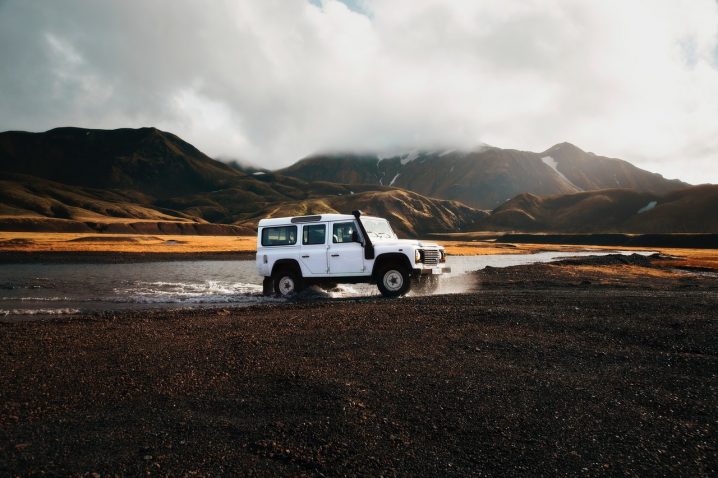It isn’t exactly a requirement to have a 4×4 in Iceland per se, but you’re severely limiting yourself without one. Iceland is not a flat, urbanised country. In fact, it’s far away from its central European neighbours in this respect. As they say, if you want a rainbow, you have to put up with some rain. Well, in Iceland if you want to see the magnificent natural wonders that it has to offer, you’ll more often than not have a bumpy journey in getting there.
This article will take a look at the roads and landscapes of Iceland, putting forward the argument of why you shouldn’t think twice about getting a 4×4.

4×4 rentals are easy to find
Whether you’re in the market for a 4×4 or an ordinary 2-wheel drive, car rentals in Iceland will have you covered. The largest airport in Iceland is in the capital, Reykjavík. Most rental cars will be present in Reykjavík airport, making it easy to hop straight off the flight and into your new travel companion.
Campers are also worth considering for your trip. Renting a 4×4 campervan meets the major considerations on the list here and your road-trip checklist for that matter, primarily comfort and road conditions. And as promised, it’s easy to find a camper. Visit Cozy Campers for affordable 4×4 camper rentals in Iceland.
Gas prices are high in Iceland. In fact, they’re the third highest in the world. You’re looking at roughly 220 isk per liter, which can regularly shocks tourists. Given how rural and sparsely populated the country is, gas stations may not always be easy to find – this should be taken into account when planning trips.
Some car rental companies may ask you to fill up the petrol tank to the top when handing back the keys, and some may not. While gas prices are high, so is public transport, so don’t let this put you off. It can be profoundly more affordable to drive your own rental vehicle, especially when travelling as a large family.
F-roads
Off-road driving is illegal in Iceland, but the experience of it certain still exists in the form of F-roads. F-roads are roads that access the highlands of Iceland; they take you to the great sightseeing spots. These roads are closer to being an off-road track than they are an urbanised, tarmac road. They can be challenging, and dangerous, but totally rewarding given their incredible routes.
You’re only allowed to drive on F-roads in a 4×4 vehicle. Your car insurance wouldn’t cover you in a 2-wheel car, or even van, because it would be too dangerous. Additionally, it’s recommended that you travel with a second person when on F-roads, in case of any trouble.
F-roads are only available for party of the year, because the rest of the year the weather conditions leave it too risky. The dates are specific to each F-road, but they generally open around June for a few months.
It’s extremely important that you factor F-roads into your route; both before you set off that day, and before your entire decision on which car to rent.
Gravel roads
So, let’s say you plan to avoid F-roads all together (perhaps you’re travelling in the winter time, when they’re closed). Sticking strictly to the Ring Road (the number one route that circles Iceland) will still leave you wishing you had a 4×4.
Around 20% of the 1,332 kilometer Ring Road remains gravel. So, excluding the F-roads, you’ll still find yourself on bumpy gravel longing for a better suspension and winter tires.
Comfort
If you’ve never driven in a 4×4, you’re probably unaware of how different it is. Suddenly, you have the space to put your backpack by your feet and your 6-man tent in the trunk. A 4×4 offers the space and comfort that can really up the luxury of your holiday.
When travelling with a family, you will be able to use all the seat and have the space for luggage. After all, Iceland has some of the most laid-back camping laws in the world, and with some incredible landscapes to hit around a campfire and admire, taking your camping gear is a great choice.
Natural wonders
Iceland is home to some of the most beautiful natural wonders in the world. It’s a particular favourite among nature lovers, with its geothermal hot springs, geysirs, volcanoes and glaciers. Iceland is home to Europe’s largest ice cap: Vatnajökull. This water glacier is an incredible site.
In the depths of Hvannadalshnukur, Iceland’s highest peak, there lies many potential volcanoes. With an area of over 3,000 square miles, the ice cap Vatnajökull is around the size of Cyprus. With around 30 outlet glaciers, the landscapes here are mind blowing.
Hvannadalshnukur, like many other must-see spots in Iceland, are a challenge to get to. It really is only worth considering getting to many of these places when running a 4×4, otherwise you’ll face vast challenges which could potentially be quite dangerous. It’s worth reading a guide to Iceland to really understand not just the roads but the landscapes of the country – you really can’t gauge the environment unless you’ve read, watched and listened to all of the stories.



